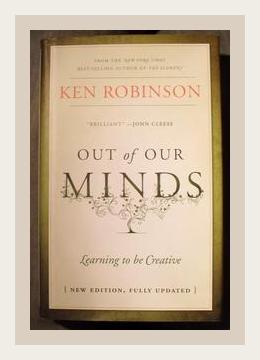Innovation and CreativityR&D Management
Ken Robinson’s “Out of Our Minds: Learning to be Creative” is a compelling examination of creativity’s role in personal growth, educational systems, and organizational success. Robinson argues that fostering creativity is essential in the 21st century, both on an individual and a collective level. The book is divided into several key themes, each underscoring different aspects of creativity and proposing actionable steps to cultivate creative environments.
1. The Importance of Creativity
Key Points
- Robinson defines creativity as a process involving original thinking and value generation.
- He emphasizes that creativity is not limited to the arts; it applies to all fields, including science, business, and education.
Examples
- Robinson cites the work of James Dyson, the inventor of the Dyson vacuum cleaner, who combined engineering skills with creative thinking to revolutionize household appliances.
Actionable Steps
- Encourage Diverse Interests: Individuals should cultivate a variety of interests and skills, as cross-disciplinary knowledge often breeds innovative ideas.
- Adopt Creative Problem-Solving: Approach problems with a mindset open to unconventional solutions, challenging traditional methods and norms.
2. Education Systems and Creativity
Key Points
- Traditional education systems often prioritize conformity and standardization, stifling creativity in the process.
- Robinson critiques the rigid structure of curricula that focus heavily on rote learning and standardized testing.
Examples
- The book discusses the example of Albert Einstein, whose creative potential was nearly undermined by an education system that failed to recognize his unique way of thinking.
Actionable Steps
- Redesign Curricula: Advocate for educational changes that prioritize critical thinking, problem-solving, and student-driven inquiry over rote memorization.
- Encourage Experiential Learning: Incorporate project-based learning and real-world problem-solving activities into education to stimulate creativity.
3. Creativity in the Workplace
Key Points
- Organizations must adapt to rapidly changing environments by fostering a culture of creativity.
- Creative workspaces encourage collaboration, innovation, and a willingness to take risks.
Examples
- Robinson highlights Google’s 20% time policy, which allows employees to spend 20% of their work time on projects they are passionate about, fostering innovation and new ideas.
Actionable Steps
- Create a Safe Environment for Risk-Taking: Encourage employees to experiment and take calculated risks without fear of failure.
- Promote Collaboration: Design workspaces and organize teams in ways that facilitate communication and the exchange of ideas.
4. Barriers to Creativity
Key Points
- Societal norms, fear of failure, and lack of support often hinder creative expression.
- Internal pressures, such as self-doubt, and external pressures, like strict hierarchies, can suppress innovative thinking.
Examples
- The book discusses the phenomenon of “groupthink” and how it stifles creativity in organizations by promoting consensus over innovation.
Actionable Steps
- Challenge Societal Norms: Actively seek to break down stereotypes and challenge norms that inhibit creative expression.
- Build Resilience: Develop personal resilience to overcome self-doubt and the fear of failure; organizations can create support systems that encourage this mindset.
5. Diversity and Creativity
Key Points
- Diversity in thought, experience, and background fuels creativity.
- Interdisciplinary approaches and diverse teams produce more innovative solutions.
Examples
- Robinson references the innovative work of the MIT Media Lab, where diverse groups of researchers from various disciplines come together to tackle complex problems.
Actionable Steps
- Foster Inclusive Environments: Promote diversity and inclusion within teams and hiring practices to bring in varied perspectives.
- Encourage Cross-Disciplinary Projects: Facilitate projects that require input from multiple disciplines, encouraging creative synergies.
6. Personal Creativity
Key Points
- Everyone possesses creative potential, but it often goes unrecognized or underdeveloped.
- Personal growth and fulfillment are closely linked to the ability to create and innovate.
Examples
- Robinson shares the story of Paul McCartney, who was initially deemed musically unremarkable by his school, yet went on to become a legendary musician.
Actionable Steps
- Pursue Passion Projects: Dedicate time to explore personal interests and hobbies, regardless of their immediate utility or practicality.
- Continuous Learning: Engage in lifelong learning to continually develop new skills and concepts that can fuel creative endeavors.
7. Leadership and Creativity
Key Points
- Effective leadership is crucial in fostering a creative environment.
- Leaders should be facilitators of creativity, providing vision and support while empowering teams to innovate.
Examples
- Robinson lauds the leadership style of Steve Jobs, who combined a strong vision with an ability to inspire and challenge his teams to pursue creative excellence.
Actionable Steps
- Be a Servant Leader: Lead by example, placing the needs of your team first to foster a supportive and innovative environment.
- Inspire and Motivate: Regularly communicate a compelling vision and purpose to keep the creativity aligned with the organization’s goals.
8. Innovation in Practice
Key Points
- Innovation is the practical application of creative ideas.
- Systems and structures should be in place to translate creative ideas into tangible outcomes.
Examples
- The development of the iPhone, combining creativity in design with technological innovation, is cited as a quintessential example of turning imaginative ideas into a groundbreaking product.
Actionable Steps
- Implement Robust Innovation Processes: Develop clear processes for capturing, evaluating, and executing creative ideas.
- Utilize Prototyping and Feedback: Adopt iterative development practices that allow for rapid prototyping and real-time feedback to refine ideas continually.
Conclusion
Ken Robinson’s “Out of Our Minds: Learning to be Creative” provides a comprehensive exploration of creativity’s critical role in today’s world. The book addresses the systemic barriers to creativity in education and the workplace while offering practical advice to individuals and organizations on nurturing a creative mindset. The actionable steps and real-world examples provided underline the powerful impact that a commitment to creativity can have on personal fulfillment, educational success, and organizational innovation. By embracing and cultivating creativity, we can unlock potential that leads to breakthroughs and progress in every field of endeavor.
